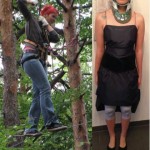How people look at you if you are using a wheelchair without being paralyzed.
How people look at you if you are using a wheelchair without being paralyzed.
A personal story by Karina Sturm
With a chronic condition like Ehlers-Danlos Syndrome I am used to aids like bandages for all my joints and neck braces but usually I try to hide them as much as I can. I do not want to look sick.
But there are situations when you need to accept extra help, like at the airport after a 10 hour flight.
All my joints hurt and I had the worst brain fog ever. I had to book airport assistance and a wheelchair and I needed help with my luggage.
Last year it was the first time I had to use the wheelchair and I had no idea what this would mean to me. I am a very stubborn and proud person and had a hard time to accept that I am chronically ill with a huge possibility of getting worse.
So here was I, in a wheelchair at the airport. I have never thought about what the world looks like out of a wheelchair. People were staring at me all the time, or it just felt like they were. Sometimes I do not even know if I just imagined they were staring or if they actually did. The first moment I noticed people looking at me was the situation when I got off the plane, walking, and sat down in my wheelchair. People can often not imagine why someone who can still use their legs needs a wheelchair after the flight.
Then I was pushed around by a really nice airport employee.
It is a weird feeling to be on the same level with peoples legs and to see how they just ignore the wheelchair. If there wasn’t this great person who pushed me around on the airport I guess people would have just fell over me. During this whole time people are not staring at you but more likely do not even recognize you are there.
Later, at the baggage claim, I had a very traumatizing event. The airport employee who helped me so nicely put me right next to the baggage claim while we were waiting for my bags. After a couple of minutes I noticed someone behind me who just pushed me away. I must have been in his way and he just pushed my wheelchair to the back so he could get in front of me. He did not say a word to me or even look at me. I was treated like an object and not like a human being. I was shocked. My assistance was as shocked as me and told that man to better go somewhere else now because this was not ok at all.
He saw my face and knew that I could not react at all. If this has happened to someone else and I would have seen it I am pretty sure that I would probably shout at this person and tell how wrong it is. I just cannot do the same if it is me. I felt so embarrassed and weak. I am used to ignorance but I was never treated like I was not there, like I was an object and not an actual human being.
Then there is the last moment when people are staring at you. It is the situation when you are finally out of the airport. I got up and out of the wheelchair and I literally saw people with open mouths. They look at you like you do not have the right to use a wheelchair.
I am young, have an invisible illness and do not show that I feel bad. And now I am walking… How does that work?
I wish I someday will be strong enough to tell all those people to be more open minded, less ignorant and just look behind peoples smile. Yes I am smiling, but if you look closer you will see the pain behind it. You will see the struggle and the frustration. I understand that it is easier to judge someone instead of trying to feel what they feel. But it is hurting really bad to be treated like someone who fakes this disease. The everyday struggles with the own body is more than enough, so it would be nice if everyone around would be more understanding. I wish there was more than being ignored or stared at.
Karina is a German EDS patient with lots of EDS comorbidities but she is struggling the most with multiple cervical spine instabilities. She is raising awareness whenever she can and found writing to be her best coping strategy.
Here is Karina’s German/English Website:
http://www.instabile-halswirbelsaeule.de/en/
and Facebook Page:
Learn more about this EDS warrior and the struggles she faces here.
1 Comment
Other Links to this Post
RSS feed for comments on this post. TrackBack URI








By Leah, February 6, 2016 @ 8:54 pm
Thank you for sharing Karina’s story. My mom spent much of my youth in a wheelchair or on crutches. I often felt like I had to be the one defending her if others stared. And as a child, that often meant just staring back. Others should be a bit more sensitive and not stare (or worse, ignore) just because they see someone not like them. If we take long enough to understand others, we will likely find they are not all that different from us.